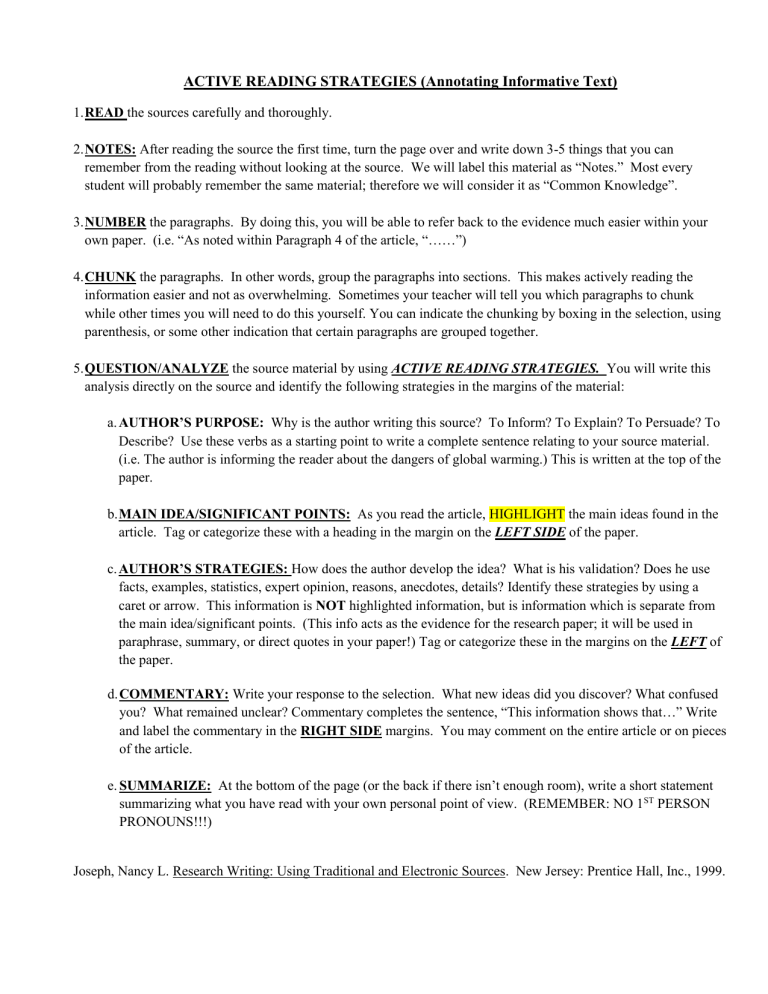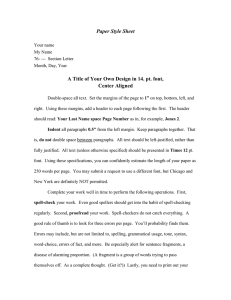ACTIVE READING STRATEGIES
advertisement

ACTIVE READING STRATEGIES (Annotating Informative Text) 1. READ the sources carefully and thoroughly. 2. NOTES: After reading the source the first time, turn the page over and write down 3-5 things that you can remember from the reading without looking at the source. We will label this material as “Notes.” Most every student will probably remember the same material; therefore we will consider it as “Common Knowledge”. 3. NUMBER the paragraphs. By doing this, you will be able to refer back to the evidence much easier within your own paper. (i.e. “As noted within Paragraph 4 of the article, “……”) 4. CHUNK the paragraphs. In other words, group the paragraphs into sections. This makes actively reading the information easier and not as overwhelming. Sometimes your teacher will tell you which paragraphs to chunk while other times you will need to do this yourself. You can indicate the chunking by boxing in the selection, using parenthesis, or some other indication that certain paragraphs are grouped together. 5. QUESTION/ANALYZE the source material by using ACTIVE READING STRATEGIES. You will write this analysis directly on the source and identify the following strategies in the margins of the material: a. AUTHOR’S PURPOSE: Why is the author writing this source? To Inform? To Explain? To Persuade? To Describe? Use these verbs as a starting point to write a complete sentence relating to your source material. (i.e. The author is informing the reader about the dangers of global warming.) This is written at the top of the paper. b. MAIN IDEA/SIGNIFICANT POINTS: As you read the article, HIGHLIGHT the main ideas found in the article. Tag or categorize these with a heading in the margin on the LEFT SIDE of the paper. c. AUTHOR’S STRATEGIES: How does the author develop the idea? What is his validation? Does he use facts, examples, statistics, expert opinion, reasons, anecdotes, details? Identify these strategies by using a caret or arrow. This information is NOT highlighted information, but is information which is separate from the main idea/significant points. (This info acts as the evidence for the research paper; it will be used in paraphrase, summary, or direct quotes in your paper!) Tag or categorize these in the margins on the LEFT of the paper. d. COMMENTARY: Write your response to the selection. What new ideas did you discover? What confused you? What remained unclear? Commentary completes the sentence, “This information shows that…” Write and label the commentary in the RIGHT SIDE margins. You may comment on the entire article or on pieces of the article. e. SUMMARIZE: At the bottom of the page (or the back if there isn’t enough room), write a short statement summarizing what you have read with your own personal point of view. (REMEMBER: NO 1ST PERSON PRONOUNS!!!) Joseph, Nancy L. Research Writing: Using Traditional and Electronic Sources. New Jersey: Prentice Hall, Inc., 1999.

